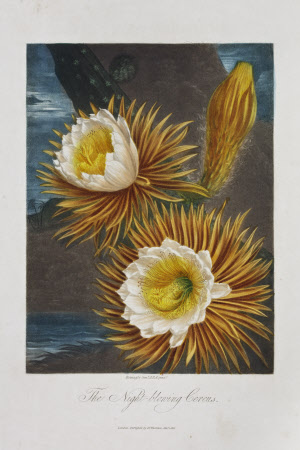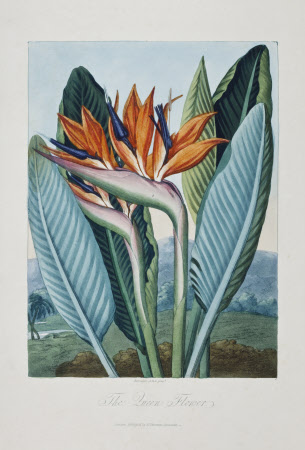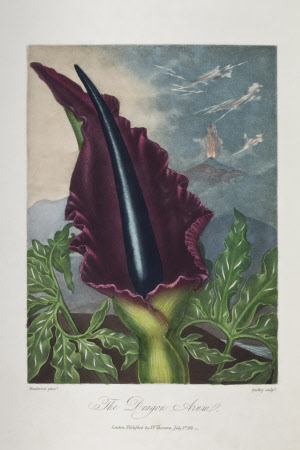Temple of Flora, : or, garden of the botanist, poet, painter, and philosopher.
Robert John Thornton (1768-1837)
Category
Books
Date
1812
Materials
Place of origin
London
Order this imageCollection
Anglesey Abbey, Cambridgeshire
NT 3101174
Summary
Robert John Thornton, New Illustrations of the Sexual System of Carolus von Linnaeus … The Temple of Flora, or Garden of Nature, London: [for the author], 1812. Binding: Nineteenth-century original pink boards; printed paper label on upper cover; as issued.
Full description
‘The Temple of Flora’ is the most magnificent flower book ever published in England. Its spectacular and dramatic plates were commissioned by Robert John Thornton (1768-1837), a London physician from a moneyed family, whose father, Burrell Thornton (d. 1768), was well known as a doctor, wit and fop. His son, educated at Cambridge and at Guy’s Hospital, invested and lost a large fortune in the project. Originally billed as the concluding part of his projected ‘New Illustration of the Sexual System of Linnaeus’, the work was announced to prospective subscribers in 1797. It was issued in parts, each one in smart green covers with pink labels; these sold initially at 12s 6d each, rising to 25s as the project progressed. In parallel to its publication, Thornton also showed the prints and drawings he had commissioned for his book in ‘Dr Thornton’s Linnaean Gallery’ in New Bond Street. Admission was by catalogue, priced 1s, and the enterprise was clearly inspired by Alderman Boydell’s ‘Shakespeare Gallery’, which had opened in 1789 and was also a combination of prestige illustrated book and public exhibition. Like Boydell’s Gallery, the whole operation was a commercial catastrophe and like the alderman before him, Thornton was forced to obtain a private Act of Parliament (1811) to authorise a lottery to recoup his losses; 20,000 tickets were offered at two guineas each, but despite a glittering array of prizes, ranging from a large a varied number of copies of the book through to the entire contents of the Linnaean Gallery, this, too, was a disaster, and Thornton was utterly ruined. Botany and botanical books were the height of fashion in late Georgian London and William Curtis, demonstrator of plants and ‘Praefectus Horti’ at the Chelsea Physic Garden, had already published his magnificent (and coloured) ‘Flora Londiniensis’ between 1777 and 1787. Thornton himself had been interested in natural history since childhood, and the ‘European Magazine’ reported in 1803 that his grandmother had once grumbled that ‘he was always catching of insects and butterflies in her garden, instead of minding his books. Hence all his weekly allowance went to maintain his garden and menagerie.’ But for all the splendour of its plates, ‘The Temple of Flora’ contained nothing very original for the man (or indeed the woman) of science, and it was marred by Thornton’s oddly grandiloquent prose. On the other hand, it was certainly magnificent, and the illustrations – of exotic, wondrous and sometimes rather sinister looking plants in suitably exotic settings – were undeniably impressive. At their most striking, they incontestably have something of the romanticism of horror’ detected by the poet and critic Geoffery Grigson in his 1951 facsimile, a book which Lord Fairhaven also owned (the technical bibliography appended to it was by Handasyde Buchanan, of the London bookseller Heywood Hill, where Fairhaven and particularly his brother Henry Broughton were regular customers). Thornton made much of the fact this his great work was ‘a national undertaking’, dedicating it to Queen Charlotte (‘the Bright Example of Conjugal Fidelity and Maternal Tenderness, Patroness of Botany and Fine Arts’, as Thornton described her with characteristic enthusiasm). He also pointed out to his subscribers that each flower was painted and engraved by ‘the most eminent British artists’, and this was true enough. The 31 plates are a mixture of aquatints, mezzotints, stipple and line engravings after original material by peter Henderson, Philip Reinagle (1749-1833), Abraham Pether (1756-1812) and Sydenham Edwards (1768-1819) they were printed in colour but finished by hand. Unsurprisingly, therefore, ‘The Temple of Flora’ is bibliographically unusually complex, and few copies are exactly alike. Lord Fairhaven owned three. Text adapted from Mark Purcell's entry in ‘Treasures from Lord Fairhaven’s Library at Anglesey Abbey’, National Trust, 2013, cat. 17. pp. 76-77.
Bibliographic description
[90] p., [31] leaves of plates (29 col.) : ill. ; fol. Pencil note on front pastedown: "In Rare State". Provenance: Twentieth-century armorial bookplate (large variant), signed Badeley 1930: Urban Huttleston Rogers Lord Fairhaven [i.e.: Urban Huttleston Broughton (1896-1966)]. Binding: Nineteenth-century original pink boards; printed paper label on upper cover.
Provenance
Acquired by Huttleston Rogers Broughton, 1st Lord Fairhaven (1896-1966) and then bequeathed by him to the National Trust with the house and the rest of the contents in 1966.
Makers and roles
Robert John Thornton (1768-1837), author Robert John Thornton (1768-1837), publisher
References
Mark Purcell, William Hale and David Person, Treasures from Lord Fairhaven’s Library at Anglesey Abbey, Swindon: National Trust; London: Scala Arts & Heritage Publishers, 2013., pp. 76-7


